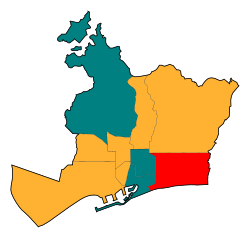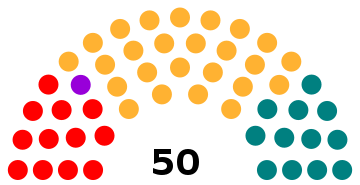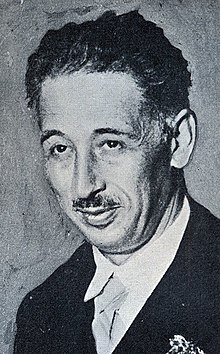1931 Barcelona City Council election
The 1931 Barcelona City Council election was held on Sunday, 12 April 1931, to elect the Barcelona City Council, the unicameral local legislature of the municipality of Barcelona. This was the first election under the Dictatorship of Primo de Rivera. At stake were all 50 seats in the City Council, determining the Mayor of Barcelona. The election was perceived as a plebiscite on Spanish Monarchy. The results lead to the Second Spanish Republic.
| ||||||||||||||||||||||
All 50 seats in the Barcelona City Council 26 seats needed for a majority | ||||||||||||||||||||||
|---|---|---|---|---|---|---|---|---|---|---|---|---|---|---|---|---|---|---|---|---|---|---|
| ||||||||||||||||||||||
 Results by district | ||||||||||||||||||||||
| ||||||||||||||||||||||
Electoral system
The number of seats of each council was determined by the population count. According to the 1877 municipal law, the population-seat relationship on each municipality was to be established on the following scale:[1]
| Population | Seats | Population | Seats | Population | Seats | ||
|---|---|---|---|---|---|---|---|
| <500 | 6 | 16,001–18,000 | 21 | 55,001–60,000 | 36 | ||
| 501–800 | 7 | 18,001–20,000 | 22 | 60,001–65,000 | 37 | ||
| 801–1,000 | 8 | 20,001–22,000 | 23 | 65,001–70,000 | 38 | ||
| 1,001–2,000 | 9 | 22,001–24,000 | 24 | 70,001–75,000 | 39 | ||
| 2,001–3,000 | 10 | 24,001–26,000 | 25 | 75,001–80,000 | 40 | ||
| 3,001–4,000 | 11 | 26,001–28,000 | 26 | 80,001–85,000 | 41 | ||
| 4,001–5,000 | 12 | 28,001–30,000 | 27 | 85,001–90,000 | 42 | ||
| 5,001–6,000 | 13 | 30,001–32,000 | 28 | 90,001–95,000 | 43 | ||
| 6,001–7,000 | 14 | 32,001–34,000 | 29 | 95,001–100,000 | 44 | ||
| 7,001–8,000 | 15 | 34,001–36,000 | 30 | 100,001–120,000 | 45 | ||
| 8,001–9,000 | 16 | 36,001–38,000 | 31 | 120,001–140,000 | 46 | ||
| 9,001–10,000 | 17 | 38,001–40,000 | 32 | 140,001–160,000 | 47 | ||
| 10,001–12,000 | 18 | 40,001–45,000 | 33 | 160,001–180,000 | 48 | ||
| 12,001–14,000 | 19 | 45,001–50,000 | 34 | 180,001–200,000 | 49 | ||
| 14,001–16,000 | 20 | 50,001–55,000 | 35 | >200,001 | 50 |
The 1907 election law established that councillors should be elected in districts consisting of 4 members, although 3 to 7 member districts were also allowed. Voters had to choose multiple candidates using limited voting, which allows a voter to vote for fewer candidates than members have to be elected. Candidates winning a plurality of votes in each district were elected. If the number of candidates was equal or fewer than the number of seats to be filled, candidates were automatically proclaimed without an election. Voting was compulsory, but not enforced, and on the basis of universal manhood suffrage, with males over twenty-five and at least a two-year residency in a municipality required to vote. Mayors were elected indirectly by the city or town council on the first session after the election.[1][2]
Results
 | ||||||
| Party | Vote | Seats | ||||
|---|---|---|---|---|---|---|
| Votes | % | ±pp | Won | +/− | ||
| Republican Left (ERC-USC) | 42,762 | 30,74 | − | 25 | − | |
| Regionalist League (LR) | 30,056 | 21.61 | − | 12 | − | |
| Republican-Socialist Coalition (PRR-PSOE) | 28,561 | 20.53 | − | 12 | − | |
| Autonomous Republicans (Rep.A) | 5,322 | 3.83 | − | 1 | − | |
| Republican Catalan Action (ACR) | 18,132 | 13.04 | − | 0 | − | |
| Spanish Patriotic Union (UP) | 3,952 | 2.84 | − | 0 | − | |
| Liberal Party (PL) | 2,445 | 1.76 | − | 0 | − | |
| Independents | 2,356 | 1.69 | − | 0 | − | |
| Dissident radicals (Rad.D) | 2,270 | 1.63 | − | 0 | − | |
| Workers and Peasants' Bloc (BOC) | 1,707 | 1.23 | − | 0 | − | |
| Traditionalist Communion (TC) | 1,216 | 0.87 | − | 0 | − | |
| Social Republican (Rep.S) | 187 | 0.13 | − | 0 | − | |
| Radio Communist (Com.Rad) | 129 | 0.09 | − | 0 | − | |
| Total | 139,095 | 100.00 | 50 | − | ||
| Source: La Veu de Catalunya, 14/04/1931 p. 4 | ||||||
Results by district
| Constituency | ERC-USC | LR | PRR-PSOE | ACR | Other monarchists | Rep.A | Other republicans | Indep. | ||||||||
|---|---|---|---|---|---|---|---|---|---|---|---|---|---|---|---|---|
| % | S | % | S | % | S | % | S | % | S | % | S | % | S | % | S | |
| I Barceloneta−Ciutat Vella | 21.0 | − | 30.4 | 3 | 30.3 | 2 | 14.1 | − | 0.0 | − | 3.1 | − | 1.2 | − | 0.0 | − |
| II Poble-sec−Montjuïc | 36.5 | 3 | 13.9 | − | 28.0 | 2 | 12.9 | − | 8.3 | − | 0.0 | − | 0.4 | − | 0.0 | − |
| III Les Corts−Sarrià | 23.9 | 1 | 29.7 | 2 | 7.7 | − | 23.0 | − | 14.0 | − | 0.0 | − | 0.1 | − | 1.7 | − |
| IV Dreta de l'Eixample | 24.3 | 2 | 30.4 | 4 | 13.3 | − | 16.1 | − | 9.9 | − | 0.8 | − | 5.2 | − | 0.0 | − |
| V Raval | 28.9 | 4 | 13.6 | − | 22.3 | 2 | 14.3 | − | 4.4 | − | 0.1 | − | 16.4 | − | 0.0 | − |
| VI Esquerra de l'Eixample | 33.1 | 3 | 28.0 | 1 | 12.4 | − | 17.2 | − | 7.0 | − | 2.2 | − | 0.0 | − | 0.0 | − |
| VII Hostafrancs−Sants | 41.8 | 4 | 12.5 | − | 21.9 | 2 | 9.9 | − | 2.0 | − | 1.4 | − | 1.9 | − | 8.5 | − |
| VIII Gràcia | 33.0 | 3 | 24.7 | 2 | 22.3 | − | 13.2 | − | 4.2 | − | 1.2 | − | 0.2 | − | 1.3 | − |
| IX Sant Andreu−Horta | 36.7 | 4 | 13.6 | − | 14.9 | 1 | 7.6 | − | 8.2 | − | 17.9 | 1 | 1.0 | − | 0.0 | − |
| X Sant Martí | 24.3 | 1 | 24.3 | − | 29.1 | 3 | 7.0 | − | 0.0 | − | 9.5 | − | 0.6 | − | 5.2 | − |
| Total | 30.7 | 25 | 21.6 | 12 | 20.5 | 12 | 13.0 | − | 5.5 | − | 3.8 | 1 | 3.1 | − | 1.7 | − |
Councillors elected
- Republican Left of Catalonia (ERC-USC)
- Jaume Aguadé i Miró
- Amadeu Aragay i Daví
- Josep Armengol de Llano
- Josep Bertran de Quintaua
- Rafael Campalaus i Puig
- Joan Casanellas
- Joan Casanovas i Maristany
- Pere Comas i Calvet
- Lluís Companys i Jover
- Francesc Costa i Martin
- Josep Duran i Guàrdia
- Josep Escofet i Andreu
- Joan Lluhí i Vallescà
- Ramon Marlés i Fanés
- Miquel Ollé i Jové
- Domènec Pla i Blanco
- Lluís Puig i Monné
- Enric Sànchez i Silva
- Jaume Vàchier i Pallé
- Salvador Vallverdú i Parxachs
- Joaquim Ventalló i Vergés
- Ernest Ventós i Casadevall
- Antoni Vilalta i Vidal
- Jaume Vinyals i Garrich
- Joaquim Xirau i Palau
- Regionalist League (LR)
- Josep Alomar i Estadas
- Frederic Amat i Arnau
- Joan Antoni Güell i Lòpez
- Andreu Bausili i Sanromà
- Frederic Brasó i Villaret
- Josep Cabré i Gelabert
- Martí Casals i Galceran
- Ferran de Sagarra i de Castellarnau
- Amadeu Llopart i Vilalta
- Josep Nonell i Pujol
- Joaquim Pellicena i Camacho
- Francesc Puig i Alfonso
- Republican-Socialist Coalition (PRR-PSOE)
- Felip de Solà i Cañizares
- Joan Domènech i Buscà
- Casimir Giralt i Bullich
- Joan Grisó i Descàrrega
- Frederic Herèdia i Valls
- Pere Huguet i Puigderrajols
- Josep Jové i Sarroca
- Mateu Ruiz i Morlan
- Pere Salvat i Pie
- Josep Samblancat i Salanova
- Jesús Ulled i Altemir
- Abel Velilla i Sarazola
- Autonomous Republican (Rep.A)
References
- "Ley municipal" (PDF). Gaceta de Madrid. 1877.
- "Ley electoral" (PDF). Gaceta de Madrid. 1907.
- "Ajuntament de Barcelona. Ciutadans regidors que el constitueixen". Gaseta municipal de Barcelona. Year 18, Num. 2 (20/04/1931), p. 2-3. Retrieved 21 August 2017.
- "Les eleccions municipals". La Veu de Catalunya, 14/04/1931, p. 4. Archived from the original on 21 August 2017. Retrieved 21 August 2017.

